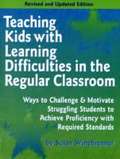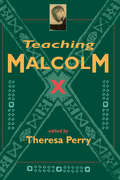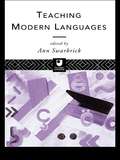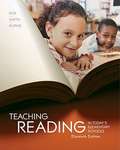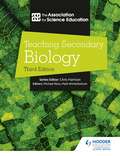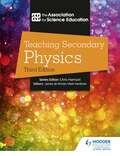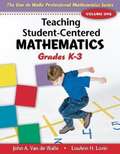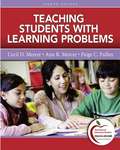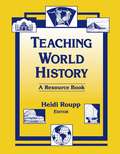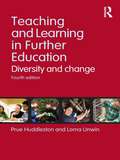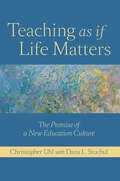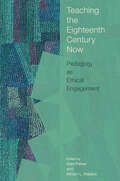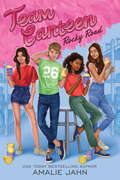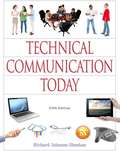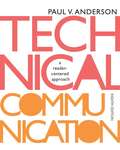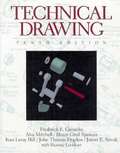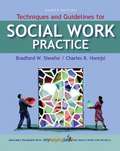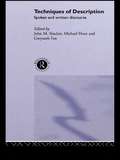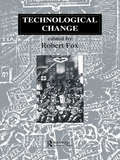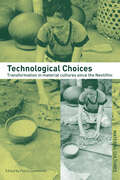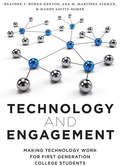- Table View
- List View
Teaching Kids with Learning Difficulties in the Regular Classroom: Ways to Challenge and Motivate Struggling Students to Achieve Proficiency with Required Standards
by Susan WinebrennerProven ways to help special education, "slow", and "remedial" students learn and achieve.
Teaching Malcolm X: Popular Culture and Literacy
by Theresa PerryThe volume brings together a dazzling array of perspectives on Malcolm X to discuss the importance of X as a cultural hero and provide guidelines for teaching Malcolm-related material at elementary, high school and university levels.
Teaching Modern Languages: Perspectives On Practice (Open University Ser.)
by Ann SwarbrickModern language classrooms are currently dominated by the communicative method of language teaching. This reader draws together recent and newly commissioned papers to show the origins of communicative methodology, how it has developed, what its research justification is and how it can most effectively be used in the classroom. Various chapters examine the particular challenges of differentiation, teaching grammar, encouraging pupils to use the target language together and teaching a foreign language to children with special educational needs. The final section discusses ways of developing creativity in the modern languages classroom through the use of drama, creative writing and role play. Anyone involved in teaching modern languages will find this reader a rich source for reflection and good practice.
Teaching Reading in Today's Elementary Schools Eleventh Edition
by Betty D. Roe Sandy H. SmithThis market-leading text sets the standard for reading instruction to ensure that aspiring teachers are able to help students learn not only how to recognize words, but also how to comprehend what they read--and enjoy the process. The book balances new approaches to reading, such as language arts integration and emergent literacy/literacy as a continuum, with more traditional foundations of strong skills and phonics instruction. Updates to the Eleventh Edition include discussion of the latest technology for literacy learning, how writing instruction impacts literacy learning, and recent movements in literacy assessment.
Teaching Secondary Biology 3rd Edition
by The Association EdEnhance your teaching with expert advice and support for Key Stages 3 and 4 Biology from the Teaching Secondary series - the trusted teacher's guide for NQTs, non-specialists and experienced teachers. Written in association with ASE, this updated edition provides best practice teaching strategies from academic experts and practising teachers.- Refresh your subject knowledge, whatever your level of expertise - Gain strategies for delivering the big ideas of science using suggested teaching sequences - Engage students and develop their understanding with practical activities for each topic - Enrich your lessons and extend knowledge beyond the curriculum with enhancement ideas - Improve key skills with opportunities to introduce mathematics and scientific literacy highlighted throughout - Support the use of technology with ideas for online tasks, video suggestions and guidance on using cutting-edge software - Place science in context; this book highlights where you can apply science theory to real-life scenarios, as well as how the content can be used to introduce different STEM careers Also available: Teaching Secondary Chemistry, Teaching Secondary Physics
Teaching Secondary Physics 3rd Edition
by The Association EdEnhance your teaching with expert advice and support for Key Stages 3 and 4 Physics from the Teaching Secondary series - the trusted teacher's guide for NQTs, non-specialists and experienced teachers. Written in association with ASE, this updated edition provides best practice teaching strategies from academic experts and practising teachers.- Refresh your subject knowledge, whatever your level of expertise - Gain strategies for delivering the big ideas of science using suggested teaching sequences - Engage students and develop their understanding with practical activities for each topic - Enrich your lessons and extend knowledge beyond the curriculum with enhancement ideas - Improve key skills with opportunities to introduce mathematics and scientific literacy highlighted throughout - Support the use of technology with ideas for online tasks, video suggestions and guidance on using cutting-edge software - Place science in context; this book highlights where you can apply science theory to real-life scenarios, as well as how the content can be used to introduce different STEM careers Also available: Teaching Secondary Chemistry, Teaching Secondary Biology
Teaching Student-Centered Mathematics (Grades K-3)
by John A. Van de Walle Louann H. LovinThe resource math teachers have been waiting for is finally here! Volume One of the Van de Walle Professional Mathematics Series provides practical guidance along with proven strategies for practicing teachers of kindergarten through grade 3. In addition to many of the popular topics and features from John Van de Walle's market-leading textbook,Elementary and Middle School Mathematics, this volume offers brand-new material specifically written for the early grades. The expanded grade-specific coverage and unique page design allow readers to quickly and easily locate information to implement in the classroom. Nearly 200 grade-appropriate activities are included. The student-centered, problem-based approach will help students develop real understanding and confidence in mathematics, making this series indispensable for teachers! Big Ideas provide clear and succinct explanations of the most critical concepts in K-3 mathematics. Problem-based activities in every chapter provide numerous engaging tasks to help students develop understanding. Assessment Notes illustrate how assessment can be an integral part of instruction and suggest practical assessment strategies. Expanded Lessons elaborate on one activity from each chapter, providing examples for creating step-by-step lesson plans for classroom implementation.
Teaching Students with Learning Problems (8th Edition)
by Paige C. Pullen Cecil D. Mercer Ann R. MercerLogically organized, comprehensive, and thoroughly applied, the eighth edition of Teaching Students with Learning Problems contains the resources teachers need to make informed decisions concerning their students with learning or behavior problems. No text on the market offers this many classroom-tested strategies, including activities and games. Unique in its coverage the materials and computer software most appropriate for students with learning problems in every content area, this top-selling text continues to be the most practical and well-researched resource for classroom teachers. New! MyEducationLabmargin notes throughout the text lead readers to online material that will deepen their understanding of important chapter topicsContent area chapters begin with assessment, then discuss the research and methods that work best with students with learning problems, followed by classroom strategies to help every student succeed. Behavior management and affective intervention coverage provides teachers with the tools to help students succeed. New! Response to Intervention coverage throughout chapters explains this important information as it relates to IDEA 2004. Common characteristics of different categories of learning problems help teachers identify problems related to instruction to better choose appropriate teaching techniques.
Teaching World History: A Resource Book (Sources And Studies In World History Ser.)
by Heidi RouppA resource book for teachers of world history at all levels. The text contains individual sections on art, gender, religion, philosophy, literature, trade and technology. Lesson plans, reading and multi-media recommendations and suggestions for classroom activities are also provided.
Teaching and Learning in A Diverse World: Multicultural Education for Young Children (3rd edition)
by Patricia G. RamseyThis book original focus on children's understanding of race, socioeconomic class, culture, and gender, while also expanding to include moral development, economic diversity, environmental concerns, and consumerism.
Teaching and Learning in Further Education: Diversity and change
by Lorna Unwin Prue HuddlestonTeaching and Learning in Further Education is established as an authoritative, wide-ranging introductory text for those training to work in the further education, post-compulsory education and lifelong learning sectors. It offers an easy to read picture of the practitioner’s everyday working life, a thorough historical account of the FE context and excellent advice on how to improve practice and enhance professional development. Essential topics covered include: Key theorists Teaching strategies Assessment issues The diverse curriculum The nature of the student body Blended learning and virtual learning E-assessment and personal records of achievement The fourth edition will be significantly updated in light of the latest research into teaching and learning, as well as extensive changes in the field including: Revision to the professional standards for teachers, tutors and trainers in the lifelong learning sector; increased provision of HE in FE; the introduction of functional skills and the 14-19 Diploma and the shifting nature of vocational qualifications. Illustrated throughout by case studies and vignettes, and supported by reflective actitities and references to well respected research and literature, Teaching and Learning in Further Education is an essential text to be used throughout an FE tutor’s journey from trainee to qualified lecturer.
Teaching and Learning in an Age of Multiple Literacies (Content Area Reading)
by Maureen MclaughlinMcLaughlin's (reading education, East Stroudsburg U. of Pennsylvania) text is designed to help pre-service and in-service teachers of science, mathematics, social science, language, the arts, physical education, and other content areas in grades 6-12. Topics addressed include an overview of 21st-century students and innovations in content area teaching; multiple literacies; standards-based teaching and high-stakes assessment; comprehending content area texts; using comprehension strategies to guide and extend thinking; teaching vocabulary; teaching culturally and linguistically diverse students; writing; using technology in content classes; critical and creative thinking; using multiple modes of representation; assessment, evaluation, and reporting; and professional development. Annotation c2010 Book News, Inc., Portland, OR (booknews.com)
Teaching as if Life Matters: The Promise of a New Education Culture
by Christopher UhlWhat would it be like to teach as if life matters? To move beyond the typical regimen of classroom exercises, homework, and standardized tests and to guide students through life’s most important lessons? Dissatisfied with traditional educational models, Christopher Uhl and Dana L. Stuchul asked themselves these questions. What they discovered will open the eyes of today’s educators to a whole new way of teaching.The authors promote an approach that fosters self-knowledge, creativity, curiosity, and an appreciation for our planet. Central to their philosophy is the question of what we humans need in order to live meaningful lives. The answer: healthy relationships with ourselves, each other, and the world. Teaching as if Life Matters is an open letter to teachers offering guidance and encouragement for nurturing students in ways that make teaching and learning meaningful. In short, it is a passionate plea for transformative teaching. Informed by the alternative educational philosophies of John Dewey, Maria Montessori, Rudolf Steiner, and Ivan Illich, this book invites teachers and students to participate in a new culture of education.This fascinating and urgently needed book will inspire today’s educators to inspire their students.
Teaching the Eighteenth Century Now: Pedagogy as Ethical Engagement (Transits: Literature, Thought & Culture, 1650-1850)
by Kate Parker Tiffany Potter Diana Epelbaum Teri Doerksen Ziona Kocher Christine D. Myers Matthew L. Reznicek Travis Chi Lau Emily C. Casey Eugenia ZuroskiIn this timely collection, teacher-scholars of “the long eighteenth century,” a Eurocentric time frame from about 1680 to 1832, consider what teaching means in this historical moment: one of attacks on education, a global contagion, and a reckoning with centuries of trauma experienced by Black, Indigenous, and immigrant peoples. Taking up this challenge, each essay highlights the intellectual labor of the classroom, linking textual and cultural materials that fascinate us as researchers with pedagogical approaches that engage contemporary students. Some essays offer practical models for teaching through editing, sensory experience, dialogue, or collaborative projects. Others reframe familiar texts and topics through contemporary approaches, such as the health humanities, disability studies, and decolonial teaching. Throughout, authors reflect on what it is that we do when we teach—how our pedagogies can be more meaningful, more impactful, and more relevant. Published by Bucknell University Press. Distributed worldwide by Rutgers University Press.
Team Canteen 1: Rocky Road
by Amalie JahnA hot pink boa that might be magic bonds 4 unlikely friends from summer camp and gives them the courage to face down the challenges they face back home.This sassy, diverse series debut for tweens is perfect for fans of XO, Kitty, The Baby-Sitters Club, and Julie and the Phantoms.On the final night of summer camp, Tasha, Raelynn, Claire, and Billie get busted stuffing themselves with ice cream in the mess hall&’s walk-in freezer. But when they slip away without being punished, they&’re convinced the pink feather boa Billie put on to stay warm is magic.Back at home, each member of Team Canteen tests the boa&’s powers as they face their own challenges. When her little cousin moves in with her destructive dog, Tasha struggles to find her place inside her adoptive family. Claire&’s scared the kids at school will find out how hard life&’s gotten since her dad lost his job. Raelynn longs to be someone other than her sister&’s twin. And with a hockey-obsessed family charting his every move, Billie&’s worried he&’ll never be able share his dream of becoming a figure skater.It&’s going to be a rocky road from the start of the school year back to Camp Happy Hollow. Will the boa continue to protect Team Canteen, or will their friendship end up being the most magical find of all?Alternating among the friends, Rocky Road is a smart, soaring celebration of the highs and lows of middle school, and the unbreakable friendships that see you through, no matter what comes next.
Technical Communication Today (Fifth Edition)
by Richard Johnson-SheehanTechnical Communication Today was written for introduction to technical communication or technical writing courses taught most often in English Departments. Technical Communication Today remains the only text to fully centralize the computer in the technical workplace, presenting how writers use computers throughout their communication process. Writers use their computers to help them think, research, compose, design, and edit. Not only is Technical Communication Today firmly rooted in core rhetorical principles, but the text also presents computers as thinking tools that powerfully influence how we develop, produce, design, and deliver technical documents and presentations. Technical Communication Today speaks to today's students and how they expect to learn information. Instructional narrative is "chunked," so that readable portions of text are combined with graphics. This presentation facilitate learning, and models the way today's technical documents should be designed. Additionally, the chunked presentation integrates an awareness of how documents are read--often "raided" by readers seeking the information they need. By mirroring these processes in its content and structure, Technical Communication Today offers readers a higher level of accessibility.
Technical Communication: A Reader-Centered Approach (Eigthth Edition)
by Paul V. AndersonThe book intends to improve the students' writing and design skills.Also includes new learning outcomes at the start of each chapter to help students gain more from their reading.
Technical Drawing (Tenth Edition)
by Henry Cecil Spencer John Thomas Dygdon James E. Novak Frederick E. Giesecke Alva Mitchell Ivan Leroy Hill Shawna LockhartThe Tenth Edition has been redesigned to appeal to today's visually oriented readers, but retains the practical step-by-step explanations of procedures and excellent problems that has made this book so successful in past editions.
Technically, You Started It
by Lana Wood JohnsonA hilarious, snarky, and utterly addicting #ownvoices debut that explores friendship, sexual orientation, mental health, and falling in love (even if things might be falling apart around you).When a guy named Martin Nathaniel Munroe II texts you, it should be obvious who you're talking to. Except there's two of them (it's a long story), and Haley thinks she's talking to the one she doesn't hate.A question about a class project rapidly evolves into an all-consuming conversation. Haley finds that Martin is actually willing to listen to her weird facts and unusual obsessions, and Martin feels like Haley is the first person to really see who he is. Haley and Martin might be too awkward to hang out in real life, but over text, they're becoming addicted to each other.There's just one problem: Haley doesn't know who Martin is. And Martin doesn't know that Haley doesn't know. But they better figure it out fast before their meet-cute becomes an epic meet-disaster . . .
Techniques and Guidelines for Social Work Practice (8th edition)
by Bradford W. Sheafor Charles R. HorejsiFocusing on the specific guidelines social workers use everyday, this textbook describes 157 techniques for communicating effectively, managing workload, serving vulnerable client populations, and practicing each phase of the planned change process.
Techniques of Description: Spoken and Written Discourse
by Michael Hoey Gwyneth Fox John M. SinclairThis book is a tribute to Malcolm Coulthard, who has been remarkably active and influential across a wide range of English Language Studies. He is particularly well-known for his pioneering work in spoken and written discourse analysis and most recently, for his work in forensic linguistics. This collection of specially commissioned, state-of-the-art pieces by leading international linguists is dedicated to the man and his achievements and provides a showcase for the most exciting developments in applied discourse studies. All the papers share common assumptions about language study: that descriptions should be data-based, data-tested and replicable. The collection as a whole contains original and important new research on descriptions, with intriuging applications to forensic, gender and literary studies.
Techno-Orientalism
by Jinny Huh Catherine Fung Abigail De Kosnik Seo-Young Chu Dylan Yeats Kathryn Allan Julie Ha Tran Aimee Bahng Jason Crum Tzarina T. Prater Douglas S. Ishii Greta A. Niu Kenneth Hough Betsy Huang Se Young Kim Warren Liu Victor Bascara David S. Roh Steve Choe Charles ParkWhat will the future look like? To judge from many speculative fiction films and books, from Blade Runner to Cloud Atlas, the future will be full of cities that resemble Tokyo, Hong Kong, and Shanghai, and it will be populated mainly by cold, unfeeling citizens who act like robots. Techno-Orientalism investigates the phenomenon of imagining Asia and Asians in hypo- or hyper-technological terms in literary, cinematic, and new media representations, while critically examining the stereotype of Asians as both technologically advanced and intellectually primitive, in dire need of Western consciousness-raising. The collection's fourteen original essays trace the discourse of techno-orientalism across a wide array of media, from radio serials to cyberpunk novels, from Sax Rohmer's Dr. Fu Manchu to Firefly. Applying a variety of theoretical, historical, and interpretive approaches, the contributors consider techno-orientalism a truly global phenomenon. In part, they tackle the key question of how these stereotypes serve to both express and assuage Western anxieties about Asia's growing cultural influence and economic dominance. Yet the book also examines artists who have appropriated techno-orientalist tropes in order to critique racist and imperialist attitudes. Techno-Orientalism is the first collection to define and critically analyze a phenomenon that pervades both science fiction and real-world news coverage of Asia. With essays on subjects ranging from wartime rhetoric of race and technology to science fiction by contemporary Asian American writers to the cultural implications of Korean gamers, this volume offers innovative perspectives and broadens conventional discussions in Asian American Cultural studies.
Technological Change: Methods and Themes in the History of Technology (Routledge Studies in the History of Science, Technology and Medicine #Vol. 1)
by Robert FoxIn this volume, scholars from these two very different traditions are brought together. Never before has a single volume contained such a distinguished and diverse group of historians of technology.
Technological Choices: Transformation in Material Cultures Since the Neolithic (Material Cultures)
by Pierre LemonnierTechnological Choices applies the critical tools of archaeology to the subject of technology and its impact on humankind throughout the ages. An examination of the challenges technological innovations present to various cultures, Technological Choices asserts that in any society, such choices are made on the basis of cultural values and social relations, rather than on the inherent benefits in technology itself. Of course, this revolutionary viewpoint has critical implications for contemporary Western societies. Based on case studies covering a wide range of chronologies and geographies, Technological Choices moves rapidly from Neolithic Europe to the modern industrial age, stopping on the way to examine the tribes of Papua, New Guinea, rural Indian and North African societies as well as several European peasant communities. The techniques studied range from the manufacture of stone implements to the development of high-tech transportation devices. With its breadth of subject matter and multidisciplinary approach, Technological Choices offers new insight into the interrelationship between technology and society. Also unprecedented is the book's emphasis on the functional aspects of material culture.
Technology and Engagement: Making Technology Work for First Generation College Students
by Mandy Savitz-Romer Heather T. Rowan-Kenyon Ana M. Martínez AlemánTechnology and Engagement is based on a four-year study of how first generation college students use social media, aimed at improving their transition to and engagement with their university. Through web technology, including social media sites, students were better able to maintain close ties with family and friends from home, as well as engage more with social and academic programs at their university. This ‘ecology of transition’ was important in keeping the students focused on why they were in college, and helped them become more integrated into the university setting. By showing the gains in campus capital these first-generation college students obtained through social media, the authors offer concrete suggestions for how other universities and college-retention programs can utilize the findings to increase their own retention of first-generation college students.
